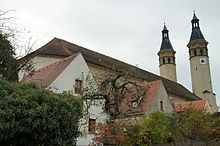Kumpfmühl-Ziegetsdorf-Neuprüll
Kumpfmühl-Ziegetsdorf-Neuprüll is the 13th district of Regensburg . The district is located in the southwest of the city, south of the city center and west of Galgenberg .
Kumpfmühl is one of the oldest parts of the city and has been part of Regensburg since 1810/18. A Roman cohort camp ( Kastell Kumpfmühl ) was located here as early as Roman times . In 1989 the Roman coin treasure of Kumpfmühl was found during construction work, with 25 gold coins and 610 silver denarii the largest in southern Germany. The largest Roman cemetery in Germany was discovered on the railway site in the north of Kumpfmühl, including the tombstone of Sarmannina, the oldest attested Christian in the region from around 400 AD. In 1350, the mill "Chupfmül", which gave the district its name first mentioned. Kumpfe were wooden bowls. The mill farm on Vitusbach stood by the Theresienkirche and was destroyed in a bomb attack on December 28, 1944. In this attack by the US Air Force, numerous houses that made up the original Kumpfmühl were either badly damaged or completely destroyed. The Church of St. Wolfgang was built by Dominikus Böhm in 1937/38 and stands at the highest point of Kumpfmühl. Near the Wolfgangskirche there are two castle truce columns that marked the border between the imperial city and the electorate of Bavaria, to which Kumpfmühl belonged. In the Gutenberg street is the so-called Zantkreuz , reminiscent of the violent death of Heinrich Zant on the Danube on 15 June 1313th
The Prüll Monastery , consecrated to St. Vitus , who gave the Neuprüll district its name , was founded in 997 by Bishop Gebhard I of Regensburg as the Benedictine Monastery of St. Bartholomew. From 1483, after the Benedictines were driven out by Duke Albrecht of Bavaria, it was run by Carthusians . In 1803 the monastery was closed and the buildings were partly demolished in the following years. From 1852 it was used as a madhouse. Today the Regensburg District Hospital is located on the site . The three-aisled hall church still preserved has two towers. Carthusian monuments are still preserved on the north wing . On January 1, 1904, the Karthaus-Prüll, Eisbuckel and Ganghofersiedlung area was incorporated into Regensburg.
The later Pope Benedict XVI worked in the Ziegetsdorf parish church of St. Josef . as a priest. On April 1, 1938, Ziegetsdorf was incorporated into the city of Regensburg. The district on a hill is dominated by the Regensburg television tower .
literature
- Parish of St. Wolfgang, Parish of St. Johannes, Advertising Association Kumpfmühl (Ed.): A district writes history. Regensburg-Kumpfmühl 79 1009 2009 . Regensburg 2008, ISBN 978-3-7917-2198-9 .
- Karl Bauer : Regensburg. Art, culture and everyday history. 5th expanded edition. MZ-Verlag, Regensburg 1997, ISBN 3-931904-19-9 , pp. 600-614.
Individual evidence
- ^ Peter Schmoll : Air raid. MZ Buchverlag Regensburg 1995, ISBN 3-927529-12-5 , p. 168
- ^ Wilhelm Volkert (ed.): Handbook of Bavarian offices, communities and courts 1799–1980 . CH Beck, Munich 1983, ISBN 3-406-09669-7 , p. 602 .
Coordinates: 49 ° 0 ' N , 12 ° 5' E






